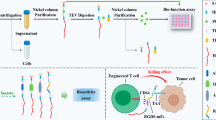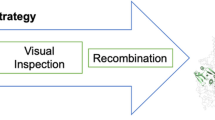Abstract
It has been previously shown that Escherichia coli l-asparaginase II (l-ASP) signal peptide is capable of being utilized to direct extracellular secretion of hirudin III (HV3) in shake flask. In this study HV3 muteins R33G34D35(S36)-HV3 were generated by introduction of adhesive recognition sequence RGD(S) into the non-functional region of HV3. The resultant recombinants were cultivated on 30 l bioreactor scale using l-ASP signal peptide expression system and the optimized fed-batch cultivation was well established. After cultivation for approximately 11 h the secreted product accumulated up to ∼1 g l−1, which means 17-fold increase in productivity compared to initial expression in shake flask. N-terminal analysis, pI measurement, and MALDI mass spectral analysis on mutein R33G34D35S36-HV3 confirmed the authenticity of the product. Compared to wild-type HV3 and R33G34D35HV3, the mutein R33G34D35S36-HV3 exhibits the improved pharmacological activity. Collectively, a novel secretion strategy using l-ASP signal peptide for the rapid, efficient and cost-effective production of HV3 mutein possessing improved pharmacological activity on bioreactor scale has been well established. Using this expression system downstream processing becomes very simple because secreted product is mature, soluble, active, and without N-terminal extension of Met, which is quite critical for most therapeutic protein to reduce the side effect in clinic use. Thus, it provides a promising alternative for extracelluar production of other difficult-to-express protein for biopharmaceutical use.








Similar content being viewed by others
Abbreviations
- HV3:
-
Hirudin III
- ATU:
-
Antithrombin units
- l-ASP:
-
l-Asparaginase II
- PCR:
-
Polymerase chain reaction
- IC50 :
-
Concentration of an inhibitor at which 50% inhibition of the response is seen
- RGD(S):
-
Adhesive recognition sequence Arg-Gly-Asp-(Ser)
- HPLC:
-
High performance liquid chromatography
- PAGE:
-
Polyacrylamide gel electrophoresis
- pI:
-
Isoelectric point
- MALDI:
-
Matrix-assisted laser desorption/ionization
References
Bender, E., Vogel, R., Koller, K. P., & Engels, J. (1990). Synthesis and secretion of hirudin by Streptomyces lividans. Applied Microbiology and Biotechnology, 34, 203–207.
Dodt, J., Schmitz, T., Schaefer, T., & Bergman, C. (1986). Expression, secretion and processing of hirudin in E. coli using the alkaline phosphatase signal sequence. FEBS Letters, 202, 373–377.
Giddings, G., Allison, G., Brooks, D., & Carter, A. (2000). Transgenic plants as factories for biopharmaceuticals. Nature Biotechnology, 18, 1151–1155.
Gumpert, J., & Hoischen, C. (1998). Use of cell wall-less bacteria (l-forms) for efficient expression and secretion of heterologous gene products. Current Opinion in Biotechnology, 9, 506–509.
Jennings, M. P., & Beacham, I. R. (1990). Analysis of the Escherichia coli gene encoding l-asparaginase II, ansB, and its regulation by cyclic AMP receptor and FNR proteins. Journal of Bacteriology, 172, 1491–1498.
Kim, M. D., Kang, H. A., Rhee, S. K., & Seo, J. H. (2001). Effects of methanol on expression of an anticoagulant hirudin in recombinant Hansenula polymorpha. Journal of Industrial Microbiology and Biotechnology, 27, 58–61.
Kim, M. D., Lee, T. H., Lim, H. K., & Seo, J. H. (2004). Production of antithrombotic hirudin in GAL1-disrupted Saccharomyces cerevisiae. Applied Microbiology and Biotechnology, 65, 259–262.
Kleist, S., Miksch, G., Hitzmann, B., Arndt, M., Friehs, K., & Flaschel, E. (2003). Optimization of the extracellular production of a bacterial phytase with Escherichia coli by using different fed-batch fermentation strategies. Applied Microbiology and Biotechnology, 61, 456–462.
Laemmli, U. K. (1970). Cleavage of structural proteins during the assembly of the head of bacteriophage T4. Nature, 227, 680–685.
Lam, T. L., Wong, R. S., & Wong, W. K. (1997). Enhancement of extracellular production of a Cellulomonas fimi exoglucanase in Escherichia coli by the reduction of promoter strength. Enzyme and Microbial Technology, 20, 482–488.
Lazarus, R. A., & McDowell, R. S. (1993). Structural and functional aspects of RGD-containing protein antagonists of glycoprotein IIb-IIIa. Current Opinion in Biotechnology, 4, 438–445.
Lowry, O. H., Rosebrough, N. J., Farr, A. L., & Randall, R. J. (1951). Protein measurement with the Folin phenol reagent. The Journal of Biological Chemistry, 193, 265–275.
Marki, W. E., & Wallis, R. B. (1990). The anticoagulant and antithrombotic properties of hirudins. Thrombosis and Haemostasis, 64, 344–348.
Mendoza-Vega, O., Hebert, C., & Brown, S. W. (1994). Production of recombinant hirudin by high cell density fed-batch cultivations of a Saccharomyces cerevisiae strain: Physiological considerations during the bioprocess design. Journal of Biotechnology, 32, 249–259.
Pugsley, A. P. (1993). The complete general secretory pathway in gram-negative bacteria. Microbiological Reviews, 57, 50–108.
Radzio, R., & Kuck, U. (1997). Efficient synthesis of the blood-coagulation inhibitor hirudin in the filamentous fungus Acremonium chrysogenum. Applied Microbiology and Biotechnology, 48, 58–65.
Riehl-Bellon, N., Carvallo, D., Acker, M., Van Dorsselaer, A., Marquet, M., Loison, G., Lemoine, Y., Brown, S. W., Courtney, M., & Roitsch, C. (1989). Purification and biochemical characterization of recombinant hirudin produced by Saccharomyces cerevisiae. Biochemistry, 28, 2941–2949.
Rosenfeld, S. A., Nadeau, D., Tirado, J., Hollis, G. F., Knabb, R. M., & Jia, S. (1996). Production and purification of recombinant hirudin expressed in the methylotrophic yeast Pichia pastoris. Protein Expression and Purification, 8, 476–482.
Rydel, T. J., Ravichandran, K. G., Tulinsky, A., Bode, W., Huber, R., Roitsch, C., & Fenton, J. W., II (1990). The structure of a complex of recombinant hirudin and human alpha-thrombin. Science, 249, 277–280.
Rydel, T. J., Tulinsky, A., Bode, W., & Huber, R. (1991). Refined structure of the hirudin-thrombin complex. Journal of Molecular Biology, 221, 583–601.
Tan, S., Wu, W., Liu, J., Kong, Y., Pu, Y., & Yuan, R. (2002). Efficient expression and secretion of recombinant hirudin III in E. coli using the l-asparaginase II signal sequence. Protein Expression and Purification, 25, 430–436.
Yamada, K. M. (1991). Adhesive recognition sequences. The Journal of Biological Chemistry, 266, 12809–12812.
Yan, X., Wang, X., Zhang, X., & Zhang, Q. (2004). Gastrointestinal absorption of recombinant hirudin-2 in rats. The Journal of Pharmacology and Experimental Therapeutics, 308, 774–779.
Acknowledgments
This work was supported by Natural Science Foundation of China, Grant Number: 30000214 and Huo Ying-Dong Scientific Research Foundation, Grant Number: 81032.
Author information
Authors and Affiliations
Corresponding author
Rights and permissions
About this article
Cite this article
Tan, S., Wu, W., Li, X. et al. Enhanced secretion of adhesive recognition sequence containing hirudin III mutein in E. coli . Mol Biotechnol 36, 1–8 (2007). https://doi.org/10.1007/s12033-007-0002-8
Received:
Revised:
Accepted:
Published:
Issue Date:
DOI: https://doi.org/10.1007/s12033-007-0002-8




